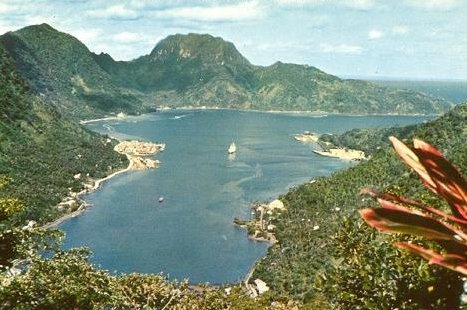Pago Pago… Where ??, yes Pago Pago, American Somoa

After my few posts about South Pacific destinations, I received some calls from customers that had looked into these destinations. They also came up with a place called Pago Pago and asked me if this is as nice as all the brochures claim, Well, I had a look (not having been there yet) and found the following information, so you decide, is this any good? (I would say YESSSSS!).
Pago Pago Harbor is the Point of Entry for all vessels arriving in American Samoa. Vessels are first cleared in Pago Pago before being allowed to enter other small boat harbors in the territory. At present, cruise liners call only upon Pago Pago Harbor, while it is common for smaller pleasure crafts (such as yachts) to visit the other ports after first clearing in Pago Pago Harbor.
Thing to Do / Highlights
FLOWER POT ROCK
The local landmark, Fatu-ma-Futi, guards the entrance to Pago Pago Bay.
FALE
These oval shaped, open-sided structures serve as the meetinghouse for traditional village councils.
FIRST MISSIONARY MONUMENT
The Reverend John Williams of the London Missionary Society landed near Leone with eight Tahitian acolytes in 1830.
JEAN P. HAYDON MUSEUM
The museum recounts the history of Samoa and exhibits Samoan art and artefacts.
TAUESE’S MUSEUM
The museum commemorates Tauese P.F. Sunria, the first popularly elected governor of American Samoa.
Island Information
Pago Pago Town is the heartbeat of American Samoa with its stunning deep water harbour (a collapsed volcanic crater) and its huge Tuna canning factories. Pago retains its clapboard buildings and red light district so romantically written about by Somerset Maughan in his book Rain.
Pago Pago remains a small town with less than 4000 residents, a couple of banks, convenience stores, restaurants, the Haydon Museum with its fine collection of ancient Samoan artefacts and lots of government departments including the National Park Headquarters and the Tourist Office located next to the yacht club at Utulei.
Pago Pago is hemmed in by towering mountains including Mt. Matafao, the highest point at 2,142 ft. and the impressive Mt. Alava which forms part of the National Park on the north coast – both mountains have trails leading to their summits and offer spectacular views. The scenic drive around the harbour passes several small beaches on the southern approach which have rocky islets protecting the lagoon making them good for swimming.
The National Park of American Samoa encompasses 2470 acres. There are only two trails in the park. The Mt. Alava 3-mile trail is the most scenic and most strenuous and is accessible from Fagasa Pass west of Pago (allow 5 hours round-trip). The Pola Island trail starts from the end of the scenic road that leads into the Park five miles east of Pago at Afono Village and offers a gentle stroll meandering through lowland forest.
East of the National Park, the south coast highway continues through tropical rainforest passing a few small villages. There’s a fine beach at Alega with good swimming and snorkelling as well as the famous Tisa’s barefoot bar which is a thriving bar / nightspot from Thursday to Saturday and quiet the rest of the week.
At Fagaitua Village a road leads inland to the villages of Masefau and Sailele on the north coast. Both offer splendid views of the wild north coast and Sailele has a gorgeous beach where you could easily spend a day doing nothing.
The coastal road offers nice views towards Aunu’u Island. The island has one sleepy village, the most authentic in American Samoa, and can be visited by local boat from Auasi Village, taking 15-minutes to cross. You can hike to the unusual Pala Lake with its quicksand and beyond to Red Lake, an extinct crater in the centre of the island and .
Tula Village on the extreme eastern point of Tutuila is a sleepy village with nice sand beach. At the far end of the village is the Meteorological Centre on the tip of Cape Matatula. The trail to the Cape takes just 10-minutes where you’ll find high cliffs and walking trails with great views along the coast and looking down into the sea where you might spot porpoise or sea turtles.
About Me

I've been a Cruise Consultant for a number of years now and I can honestly say that it is just the best job ever. No two days are the same. I have got to know some fantastic people through the course of my job, both in the industry and clients,…
Read more